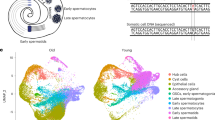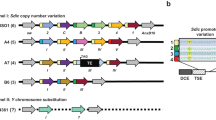Abstract
Genomic imprinting is an epigenetic state that results from differential processing of chromosomes during gametogenesis and which can cause differential expression of genes depending on the sex of the parent transmitting that gene. In Drosophila, many examples of imprinted marker genes have been documented and imprinting of these genes involves highly conserved epigenetic regulators. However, no endogenously imprinted genes have yet been identified. Here we present a phenotypic and transcriptional analysis of parthenogenetic (gynogenetic) and genotypically identical but sexually produced adult female Drosophila. We find that while parthenogenetic females have a superficially normal phenotype and are viable and fertile, their lifespan is extended relative to their sexually-produced counterparts. Microarray/transcriptional analysis of parthenogenetic versus sexually-produced females reveals 76 genes with consistently altered patterns of expression, 36 upregulated and 40 downregulated, some with known effects on aging. Analysis of individuals with uniparental inheritance of only portions of their genome suggest that many of these genes may be indirectly imprinted, responding to either other imprinted genes or redistribution of chromatin components that are differentially allocated to sex and autosomal heterochromatin in a sex-dependent manner during gametogenesis. As gene expression dependent on the parental origin of the genome meets the definition of genomic imprinting, our study provides evidence that endogenous genes are imprinted in Drosophila.

Similar content being viewed by others
References
Alleman M, Doctor J (2000) Genomic imprinting in plants: observations and evolutionary implications. Plant Mol Biol 43:147–161
Anaka M, Lynn A, McGinn P, Lloyd VK (2009) Genomic imprinting in Drosophila has properties of both mammalian and insect imprinting. Dev Genes Evol 219(2):59–66
Antosh M, Fox D, Helfand SL, Cooper LN, Neretti N (2011) New comparative genomics approach reveals a conserved health span signature across species. Aging 3:576–583
Bean CJ, Schaner CE, Kelly WG (2004) Meiotic pairing and imprinted X chromatin assembly in Caenorhabditis elegans. Nat Genet 36:100–105
Contrino S, Smith RN, Butano D, Carr A, Hu F, Lyne R, Rutherford K, Kalderimis A, Sullivan J, Carbon S, Kephart ET, Lloyd P, Stinson EO, Washington NL, Perry MD, Ruzanov P, Zha Z, Lewis SE, Stein LD, Micklem G (2012) modMine: flexible access to modENCODE data. Nucleic Acids Res 40:D1082–D1088
Coolon JD, Stevenson KR, McManus CJ, Graveley BR, Wittkopp PJ (2012) Genomic imprinting absent in Drosophila melanogaster adult females. Cell Rep 2(1):69–75
Davies W, Isles A, Smith R, Karunadasa D, Burrmann D, Humby T, Ojarikre O, Biggin C, Skuse D, Burgoyne P, Wilkinson L (2005) Xlr3b is a new imprinted candidate for X-linked parent-of-origin effects on cognitive function in mice. Nat Genet 37:625–629
Dubruille R, Orsi GA, Delabaere L, Cortier E, Couble P, Marais GA, Loppin B (2010) Specialization of a Drosophila capping protein essential for the protection of sperm telomeres. Curr Biol 20:2090–2099
Ferree PM, Sullivan W (2006) A genetic test of the role of the maternal pronucleus in Wolbachia-induced cytoplasmic incompatibility in Drosophila melanogaster. Genetics 173:839–847
Fuyama Y (1984) Gynogenesis in Drosophila melanogaster. Jpn J Genet 59:91–96
Fuyama Y (1986) Genetics of parthenogenesis in Drosophila melanogaster. II. Characterization of a gynogenetically reproducing strain. Genetics 114:495–509
Gao G, Cheng Y, Wesolowska N, Rong YS (2011) Paternal imprint essential for the inheritance of telomere identity in Drosophila. Proc Natl Acad Sci USA 108:4932–4937
Gibson G, Riley-Berger R, Harshman L, Kopp A, Vacha S, Nuzhdin S, Wayne M (2004) Extensive sex-specific nonadditivity of gene expression in Drosophila melanogaster. Genetics 167:1791–1799
Golic KG, Golic MM, Pimpinelli S (1998) Imprinted control of gene activity in Drosophila. Curr Biol 8:1273–1276
Haller BS, Woodruff RC (2000) Varied expression of a Y-linked P[w+] insert due to imprinting in Drosophila melanogaster. Genome 43(2):285–292
Jiang PP, Hartl DL, Lemos B (2010) Y not a dead end: epistatic interactions between Y-linked regulatory polymorphisms and genetic background affect global gene expression in Drosophila melanogaster. Genetics 186:109–118
Joanis V, Lloyd VK (2002) Genomic imprinting in Drosophila is maintained by the products of Suppressor of variegation and trithorax group, but not Polycomb group, genes. Mol Genet Genomics 268:103–112
Jullien PE, Berger F (2009) Gamete-specific epigenetic mechanisms shape genomic imprinting. Curr Opin Plant Biol 12:637–642
Kalfayan L, Wensink PC (1982) Developmental regulation of Drosophila alpha-tubulin genes. Cell 29:91–98
Khosla S, Mendiratta G, Brahmachari V (2006) Genomic imprinting in the mealybugs. Cytogenet Genome Res 113:41–52
Komma DJ, Endow SA (1995) Haploidy and androgenesis in Drosophila. Proc Natl Acad Sci USA 92:11884–11888
Lemos B, Araripe LO, Hartl DL (2008) Polymorphic Y chromosomes harbor cryptic variation with manifold functional consequences. Science 319:91–93
Lemos B, Branco AT, Hartl DL (2010) Epigenetic effects of polymorphic Y chromosomes modulate chromatin components, immune response, and sexual conflict. Proc Natl Acad Sci USA 107:15826–15831
Lemos B, Branco AT, Jiang PP, Hartl DL, Meiklejohn CD (2013) Genome-wide gene expression effects of sex chromosome imprinting in Drosophila. G3 (Bethesda) 4(1):1–10 (pii:g3.113.008029v1)
Lloyd V (2000) Parental imprinting in Drosophila. Genetica 109:35–44
MacDonald WA (2012) Epigenetic mechanisms of genomic imprinting: common themes in the regulation of imprinted regions in mammals, plants, and insects. Genet Res Int. doi:10.1155/2012/585024
MacDonald WA, Menon D, Bartlett NJ, Sperry GE, Rasheva V, Meller V, Lloyd VK (2010) The Drosophila homolog of the mammalian imprint regulator, CTCF, maintains the maternal genomic imprint in Drosophila melanogaster. BMC Biol 8:105
Maggert KA, Golic KG (2002) The Y chromosome of Drosophila melanogaster exhibits chromosome-wide imprinting. Genetics 162:1245–1258
Martin CC, McGowan R (1995) Genotype-specific modifiers of transgene methylation and expression in the zebrafish, Danio rerio. Genet Res 65:21–28
Matthews KA, Miller DF, Kaufman TC (1989) Developmental distribution of RNA and protein products of the Drosophila alpha-tubulin gene family. Dev Biol 132:45–61
McDonald HB, Goldstein LS (1990) Identification and characterization of a gene encoding a kinesin-like protein in Drosophila. Cell 61:991–1000
McDonald HB, Stewart RJ, Goldstein LS (1990) The kinesin-like ncd protein of Drosophila is a minus end-directed microtubule motor. Cell 63:1159–1165
McGrath J, Solter D (1984) Completion of mouse embryogenesis requires both the maternal and paternal genomes. Cell 37:179–183
Menon DU, Meller VH (2009) Imprinting of the Y chromosome influences dosage compensation in roX1 roX2 Drosophila melanogaster. Genetics 183:811–820
Menon DU, Meller VH (2010) Germ line imprinting in Drosophila: epigenetics in search of function. Fly 4(1):48–52
Michalak P (2009) Epigenetic, transposon and small RNA determinants of hybrid dysfunctions. Heredity 102(1):45–50
Morison IM, Ramsay JP, Spencer HG (2005) A census of mammalian imprinting. Trends Genet 21:457–465
Neal SJ, Gibson ML, So AK, Westwood JT (2003) Construction of a cDNA-based microarray for Drosophila melanogaster: a comparison of gene transcription profiles from SL2 and Kc167 cells. Genome 46:879–892
Noujdin NI (1944) The regularities of heterochromatin influence on mosaicism. Zh Obshch Biol 5:357–388
Novitski E, Grace D, Strommen C (1981) The entire compound autosomes of Drosophila melanogaster. Genetics 98:257–273
Pardo-Manuel de Villena F, de la Casa-Esperón E, Sapienza C (2000) Natural selection and the function of genomic imprinting: beyond the silenced minority. Trends Genet 16:573–579
Partridge L (2011) Some highlights of research on aging with invertebrates, 2010. Aging Cell 10:5–9
Peters J, Beechey C (2004) Identification and characterisation of imprinted genes in the mouse. Brief Funct Genomics Proteomic 2:320–333
Pimpinelli S, Berloco M, Fanti L, Dimitri P, Bonaccorsi S, Marchetti E, Caizzi R, Caggese C, Gatti M (1995) Transposable elements are stable structural components of Drosophila melanogaster heterochromatin. Proc Natl Acad Sci USA 92:3804–3808
Plagge A, Isles AR, Gordon E, Humby T, Dean W, Gritsch S, Fischer-Colbrie R, Wilkinson LS, Kelsey G (2005) Imprinted Nesp55 influences behavioral reactivity to novel environments. Mol Cell Biol 25:3019–3026
Rera M, Clark RI, Walker DW (2012) Intestinal barrier dysfunction links metabolic and inflammatory markers of aging to death in Drosophila. Proc Natl Acad Sci USA 109:21528–21533
Rodrigues JC, Luo M, Berger F, Koltunow AM (2010) Polycomb group gene function in sexual and asexual seed development in angiosperms. Sex Plant Reprod 23(2):123–133
Scott RJ, Spielman M (2006) Deeper into the maize: new insights into genomic imprinting in plants. BioEssays 28:1167–1171
Seong KM, Kim CS, Seo SW, Jeon HY, Lee BS, Nam SY, Yang KH, Kim JY, Kim CS, Min KJ, Jin YW (2011) Genome-wide analysis of low-dose irradiated male Drosophila melanogaster with extended longevity. Biogerontology 12:93–107
Siebold AP, Banerjee R, Tie F, Kiss DL, Moskowitz J, Harte PJ (2010) Polycomb Repressive Complex 2 and Trithorax modulate Drosophila longevity and stress resistance. Proc Natl Acad Sci USA 107:169–174
Spofford JB (1976) Position-effect variegation in Drosophila. In: Ashburner M, Novitski E (eds) The genetics and biology of Drosophila. Academic Press, London, pp 955–1018
Sun FL, Cuaycong MH, Craig CA, Wallrath LL, Locke J, Elgin SC (2000) The fourth chromosome of Drosophila melanogaster: interspersed euchromatic and heterochromatic domains. Proc Natl Acad Sci USA 97:5340–5345
Surani MA, Barton SC, Norris ML (1984) Development of reconstituted mouse eggs suggests imprinting of the genome during gametogenesis. Nature 308:548–550
Thomas PD, Campbell MJ, Kejariwal A, Mi H, Karlak B, Daverman R, Diemer K, Muruganujan A, Narechania A (2003) PANTHER: a library of protein families and subfamilies indexed by function. Genome Res 13:2129–2141
Tower J (2000) Transgenic methods for increasing Drosophila life span. Mech Ageing Dev 118:1–14
Tweedie S, Ashburner M, Falls K, Leyland P, McQuilton P, Marygold S, Millburn G, Osumi-Sutherland D, Schroeder A, Seal R, Zhang H (2009) FlyBase: enhancing Drosophila gene ontology annotations. Nucleic Acids Res 37:D555–D559
Wittkopp PJ, Haerum BK, Clark AG (2006) Parent-of-origin effects on mRNA expression in Drosophila melanogaster not caused by genomic imprinting. Genetics 173:1817–1821
Wood AJ, Oakey RJ (2006) Genomic imprinting in mammals: emerging themes and established theories. PLoS Genet 2(11):e147
Zhang P, Timakov B, Stankiewicz RL, Turgut IY (2000) A trans-activator on the Drosophila Y chromosome regulates gene expression in the male germ line. Genetica 109:141–150
Zou S, Meadows S, Sharp L, Jan LY, Jan YN (2000) Genome-wide study of aging and oxidative stress response in Drosophila melanogaster. Proc Natl Acad Sci USA 97:13726–13731
Zuckerkandl E (1974) A possible role of ‘inert’ heterochromatin in cell differentiation. Action of and competition for ‘locking’ molecules. Biochimie 56:937–954
Acknowledgments
This work was supported by a Natural Sciences and Engineering Council of Canada grant to V.K.L and graduate scholarship to L.A.M. We thank Margaret Beaton and the anonymous reviewers for their comments as well as Tim Westwood and Scott Neal of the Canadian Drosophila Microarray Centre for assistance with microarray hybridization and analysis, and the Bloomington Indiana stock center for Drosophila stocks.
Author information
Authors and Affiliations
Corresponding author
Additional information
Communicated by S. Hohmann.
Electronic supplementary material
Below is the link to the electronic supplementary material.
Rights and permissions
About this article
Cite this article
McEachern, L.A., Bartlett, N.J. & Lloyd, V.K. Endogenously imprinted genes in Drosophila melanogaster . Mol Genet Genomics 289, 653–673 (2014). https://doi.org/10.1007/s00438-014-0840-6
Received:
Accepted:
Published:
Issue Date:
DOI: https://doi.org/10.1007/s00438-014-0840-6




